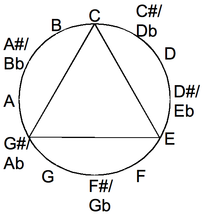Major-thirds tuning
| Major thirds | |
|---|---|

Each major-thirds tuning packs the octave's 12 notes into 3 strings' 4 frets.
|
|
| Basic information | |
| Aliases | All-thirds (M3) tuning Augmented tuning |
| Interval | Major third |
| Semitones | 4 |
| Example(s) | G♯-C-E-G♯-C-E |
| Advanced information | |
| Repetition | After 3 strings |
| Advantages | Octave on 4 frets, Major–minor chords on 2 |
| Disadvantages | Reduced range on 6 strings |
| Left-handed tuning | Minor-sixths tuning |
 |
|
| Ralph Patt popularized major-thirds tuning. | |
| Regular tunings (semitones) | |
| Trivial (0) | |
| Minor thirds (3) | |
| Major thirds (4) | |
| All fourths (5) | |
| Augmented fourths (6) | |
| New standard (7, 3) | |
| All fifths (7) | |
| Minor sixths (8) | |
| Guitar tunings | |
Among alternative tunings for guitar, a major-thirds tuning is a regular tuning in which each interval between successive open strings is a major third ("M3" in musical abbreviation). Other names for major-thirds tuning include major-third tuning, M3 tuning, all-thirds tuning, and augmented tuning. By definition, a major-third interval separates two notes that differ by exactly four semitones (one-third of the twelve-note octave).
The Spanish guitar's tuning mixes four perfect fourths (five semitones) and one major-third, the latter occurring between the G and B strings:
This tuning, which is used for acoustic and electric guitars, is called "standard" in English, a convention that is followed in this article. While standard tuning is irregular, mixing four fourths and one major third, M3 tunings are regular: Only major-third intervals occur between the successive strings of the M3 tunings, for example, the open augmented C tuning
For each M3 tuning, the open strings form an augmented triad in two octaves.
For guitars with six strings, every major-third tuning repeats its three open-notes in two octaves, so providing many options for fingering chords. By repeating open-string notes and by having uniform intervals between strings, major-thirds tuning simplifies learning by beginners. These features also facilitate advanced guitarists' improvisation, precisely the aim of jazz guitarist Ralph Patt when he began popularizing major-thirds tuning between 1963 and 1964.
...
Wikipedia
